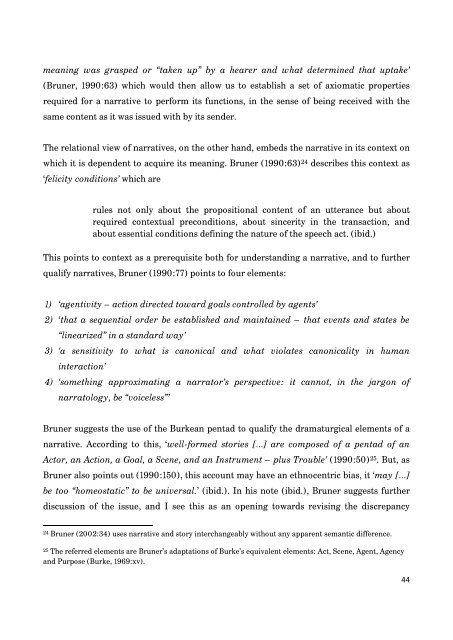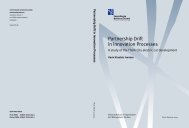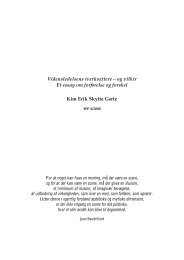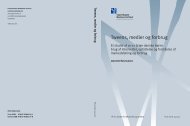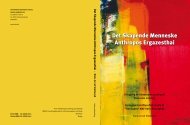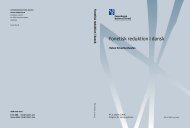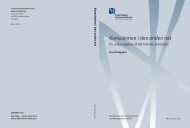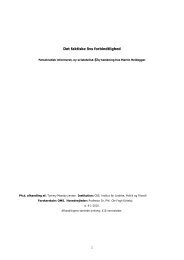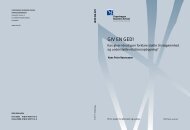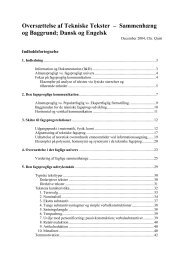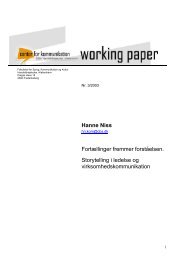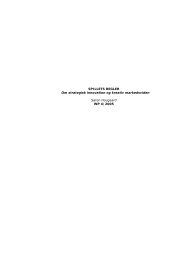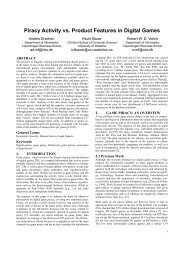- Page 1 and 2: copenhagen business school handelsh
- Page 3 and 4: Søren Friis Møller From Disintere
- Page 5 and 6: Index Chapter 0 Prologue p.7 Chapte
- Page 7 and 8: 8.4 Contributions from and to Relat
- Page 9 and 10: However, it is not just a story of
- Page 11 and 12: I open the project with an article
- Page 13 and 14: esearch project. I should notify th
- Page 15 and 16: A Facelifted Dead Body - Who Cares?
- Page 17 and 18: you do have to be a bit dictatorial
- Page 19 and 20: and if follows that acknowledging t
- Page 21 and 22: leadership socially and vice versa.
- Page 23 and 24: legitimacy. Sweder (1984:27) has de
- Page 25 and 26: paradoxical way seem to defend an e
- Page 27 and 28: specific field, I design my researc
- Page 29 and 30: esearcher’s ability to allow for
- Page 31 and 32: • Stakeholder based definitions,
- Page 33 and 34: produce meaning. This means, that a
- Page 35 and 36: Chapter 1 sets the scene through an
- Page 37 and 38: Chapter 2 Epistemological Framework
- Page 39 and 40: Thus, the outcome of a PhD research
- Page 41 and 42: elational processes in which we coo
- Page 43: cultural sector is organized around
- Page 47 and 48: (2000:32) points to the intrinsic v
- Page 49 and 50: such purposes as to justify events
- Page 51 and 52: orders are constituted in the inter
- Page 53 and 54: 1988:49) to underscore that plots a
- Page 55 and 56: grasping the process of leading nar
- Page 57 and 58: of actions and of consciousness (19
- Page 59 and 60: for the construction of narratives.
- Page 61 and 62: With these four forms of narratives
- Page 63 and 64: 2.3 Methodology and Methods If ‘a
- Page 65 and 66: time how this ontologizes leadershi
- Page 67 and 68: with the exception of the cases of
- Page 69 and 70: for the more activist aspirations (
- Page 71 and 72: Taking the question of what may be
- Page 73 and 74: as they in a tautological way equal
- Page 75 and 76: transcendence in beauty prompted a
- Page 77 and 78: later financial power. But to me at
- Page 79 and 80: about science, morality and for my
- Page 81 and 82: Kant’s Contributions and the Hero
- Page 83 and 84: evelatory process of the subject’
- Page 85 and 86: Gautier, in spite of his young age,
- Page 87 and 88: The personality of the artists, at
- Page 89 and 90: 3.3 Cultural Policies and the Arm
- Page 91 and 92: secretary that she happens to be on
- Page 93 and 94: Now it isn’t the most current wor
- Page 95 and 96:
d) through the above activities, th
- Page 97 and 98:
In France a new Ministry of Culture
- Page 99 and 100:
counts as art and culture is by no
- Page 101 and 102:
professionalism in the way public s
- Page 103 and 104:
Museums have to make selections. Ch
- Page 105 and 106:
the main purpose of the inquiry is
- Page 107 and 108:
Chapter 4 Challenging the Myth ‘A
- Page 109 and 110:
narrative reiteration of those laws
- Page 111 and 112:
4.1 White Cube for Some and White Q
- Page 113 and 114:
ethnicity, gender, sexuality, race,
- Page 115 and 116:
have to engage in ‘series of cult
- Page 117 and 118:
seems less confrontational to seek
- Page 119 and 120:
category such as ‘art’ is grant
- Page 121 and 122:
grassroots feeling to it, and as po
- Page 123 and 124:
quarters, who don’t spend time wa
- Page 125 and 126:
of high art and culture to the leve
- Page 127 and 128:
seeing audiences only as a construc
- Page 129 and 130:
4.4 Situating Leadership Responses
- Page 131 and 132:
constitute each other. In concrete
- Page 133 and 134:
the process of participating, encou
- Page 135 and 136:
Chapter 5 Leadership as an Aspect o
- Page 137 and 138:
elations, thereby situating art as
- Page 139 and 140:
indigenous groups, that globalizati
- Page 141 and 142:
uncontrollable and devastating cons
- Page 143 and 144:
Andrea: ‘Unhappy is the land that
- Page 145 and 146:
and appreciating the results of the
- Page 147 and 148:
whereas the white cube, the iconic
- Page 149 and 150:
carrying out this project. In stron
- Page 151 and 152:
So in terms of the cultural sector,
- Page 153 and 154:
count. In the next section, I go fu
- Page 155 and 156:
to a sense of disenfranchisement vi
- Page 157 and 158:
Cultural actors and institutions, a
- Page 159 and 160:
narrative of disinterested knowledg
- Page 161 and 162:
(1999:ix), outside of relationally
- Page 163 and 164:
world, it’s how people make sense
- Page 165 and 166:
aim at producing the sensation that
- Page 167 and 168:
Chapter 6 Case Study I Malmoe City
- Page 169 and 170:
all the hostility she is met with.
- Page 171 and 172:
and future borrower. Framing the st
- Page 173 and 174:
Prime Minister, Göran Persson, him
- Page 175 and 176:
in the park. The Calender of Light
- Page 177 and 178:
during the day and a will to be par
- Page 179 and 180:
MCL wants to do a paradigm shift. W
- Page 181 and 182:
explained as part of the ordinary b
- Page 183 and 184:
- That everyday, 3000 titles are be
- Page 185 and 186:
The conversation amongst people in
- Page 187 and 188:
We defend ourselves against the dev
- Page 189 and 190:
MCL too but it is difficult. I have
- Page 191 and 192:
market, then why should the library
- Page 193 and 194:
The point is not that one should be
- Page 195 and 196:
‘Experience’ in this context sh
- Page 197 and 198:
It is in light of this initial disa
- Page 199 and 200:
park. This, the NOP argues, is base
- Page 201 and 202:
• It has pointed to the limits of
- Page 203 and 204:
the MCL’s conditions in terms of
- Page 205 and 206:
as art and culture cannot be reduce
- Page 207 and 208:
Chapter 7 Three Case Studies My stu
- Page 209 and 210:
well-reputed theater, invests human
- Page 211 and 212:
have the two initiators’ reflecti
- Page 213 and 214:
- Showing the good example by inves
- Page 215 and 216:
The municipal challenge is that the
- Page 217 and 218:
orrowed space in a local gym. Today
- Page 219 and 220:
eflect on the seeming incompatibili
- Page 221 and 222:
that not much happens which has not
- Page 223 and 224:
defending brick-buildings and forma
- Page 225 and 226:
million, and Daily Mail’s Rebecca
- Page 227 and 228:
the orchestra has been through a di
- Page 229 and 230:
main concert from 21-22 o'clock bei
- Page 231 and 232:
- (usually people are really good a
- Page 233 and 234:
Based on the original recording wit
- Page 235 and 236:
7.4 Reconstructing the Three Case S
- Page 237 and 238:
• As the previous case study, it
- Page 239 and 240:
’You can do everything with bayon
- Page 241 and 242:
or neurological 102 traits as claim
- Page 243 and 244:
y what is being studied, great lead
- Page 245 and 246:
feelings, and behaviors of a signif
- Page 247 and 248:
And here comes the unexpected in Ga
- Page 249 and 250:
Perhaps the most paradoxical aspect
- Page 251 and 252:
To this list my inquiry suggests to
- Page 253 and 254:
knowledge, backed up by cultural po
- Page 255 and 256:
tale of leadership, are likely to p
- Page 257 and 258:
wherefore RLT is little concerned w
- Page 259 and 260:
RLT as Problematizing Leadership As
- Page 261 and 262:
and culture, and how might we chang
- Page 263 and 264:
these values over the ways of life
- Page 265 and 266:
Reconstructing Case Studies around
- Page 267 and 268:
constructed the study of the MCL to
- Page 269 and 270:
whereas those who are outside will
- Page 271 and 272:
do with a city district in terms of
- Page 273 and 274:
Thus, in a sense the inquiry is fig
- Page 275 and 276:
some very fertile grounds in the na
- Page 277 and 278:
In this regard, it has been product
- Page 279 and 280:
narratively. By studying leadership
- Page 281 and 282:
Contributing to Leadership Studies
- Page 283 and 284:
In the project, I have approached a
- Page 285 and 286:
common denominator of these contrib
- Page 287 and 288:
Bates, A. 1906, The Drama: Its Hist
- Page 289 and 290:
Bryt 2009, Jag håller helt med And
- Page 291 and 292:
DiMaggio, P.J. & Mukhtar, T. 2004,
- Page 293 and 294:
Gergen, K.J., Gergen, M., Barrett,
- Page 295 and 296:
Hjorth, D. 2007, " Lessons from Iag
- Page 297 and 298:
Kant, I. 1790, Critique of Judment,
- Page 299 and 300:
Moore, H.L. 2007, ”The Problem of
- Page 301 and 302:
Rohde, H. 1996, Om Kulturministerie
- Page 303 and 304:
Syberg, K. 2009, En rigtig minister
- Page 305 and 306:
Wright, S., Newbigin, J., Kieffer,
- Page 307 and 308:
dominant narrative and to make new
- Page 309 and 310:
opfordrer den til yderligere rekons
- Page 311 and 312:
19. Thomas Lyse Hansen Six Essays o
- Page 313 and 314:
30. Ole Hinz Den effektive forandri
- Page 315 and 316:
11. Christian Moldt-Jørgensen Fra
- Page 317 and 318:
12. Claus Bajlum Essays on Credit R
- Page 319 and 320:
24. Christian Scheuer Employers mee
- Page 321 and 322:
36. Annegrete Juul Nielsen Travelin
- Page 323 and 324:
9. Thomas Frandsen Managing Modular
- Page 325:
TITLER I ATV PH.D.-SERIEN 1992 1. N


